Growing Tomatoes Part 2: Transplanting Outdoors & Care
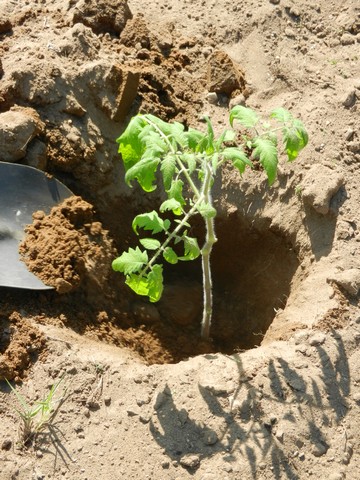
Growing Tomatoes; Transplanting Outdoors & General Care
After seeding inside, then transplanting tiny seedlings to larger pots to grow and develop, the time will eventually come when the plants will need to move outside. In this post, based on my personal experience (I am a hobby gardener and not a professional), I will show you how to get your tomato plants ready for the outdoors and how to further care for them. In my previous post, Growing Tomatoes Part 1: Seeding & Transplanting Seedlings, I went through the process of seeding and caring for tomato sprouts. Growing Tomatoes Part 3: Common Problems & Solutions is also worth reading to keep you a step ahead, preventing disease.
Once tomato sprouts have reached a certain size, such as in the picture below, they will take off and grow very quickly; several inches a week is not uncommon. Tomato plants crave direct sun and warmth all day long and they will also absorb a lot of water. I often water twice a day at this stage, with holes on the bottom of the cups to allow drainage.
May 1:
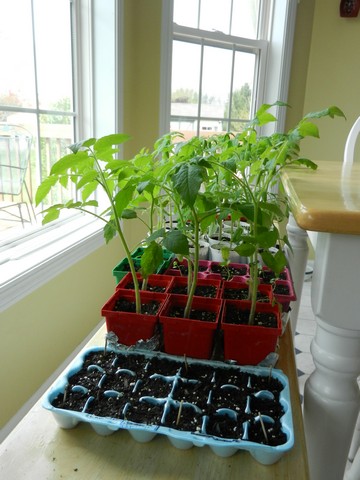
May 6:
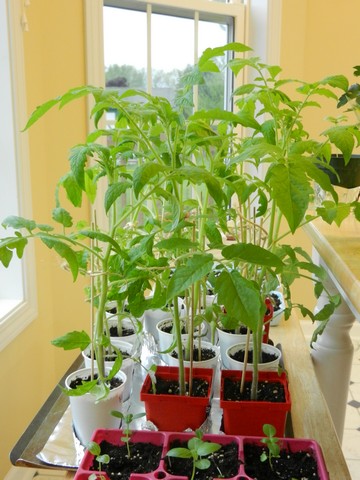
If you have extra plants on hand to share with friends and family, this is a good time to pass them along.
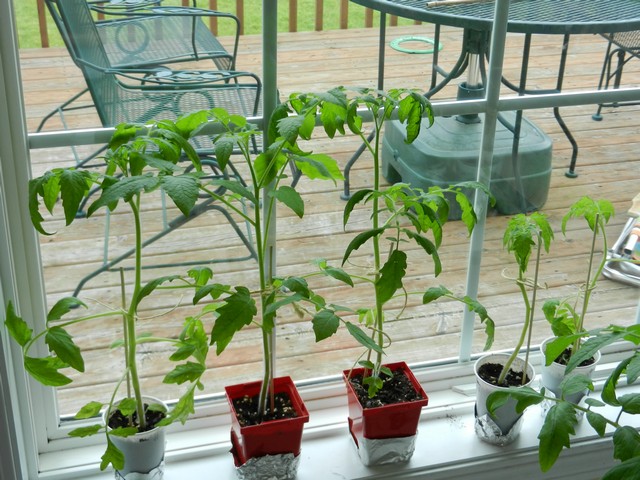
Preparing for Transplanting Outdoors: Weathering
Once the weather has warmed up sufficiently and the danger of night frost has just about passed, it is time to “weather” your plants in preparation for outdoor transplanting. Weathering means to gradually get them used to the climate outdoors where they will be exposed to the elements, such as the different air, wind, and the sun hitting them directly instead of through a window. If planted directly outdoors without weathering first, your plants could experience a shock and may not make it. So, bring them outside to a safe spot for a few hours a day, gradually increasing over the next week to all day outside and bringing them inside at night for protection.
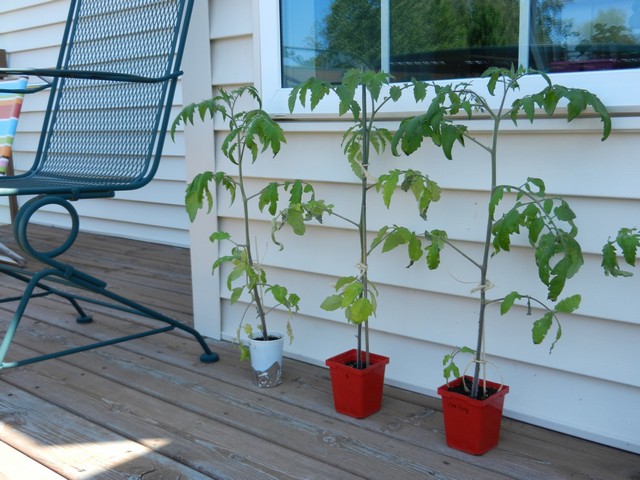
On lightly windy days I support the the pots to keep the plants upright and from falling over. I have found water-filled 2-liter soda bottles to be helpful.
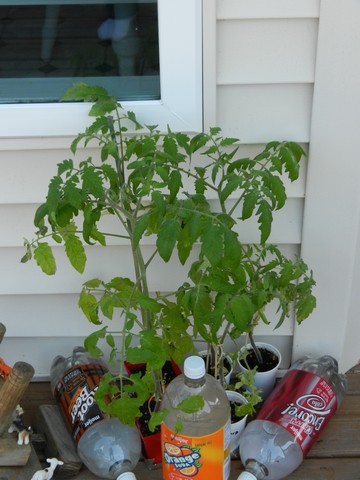
However, I have to tell you about an accident I had one year, when wind gusts caused one plant to snap in the middle, even with stakes in place! I though this plant was a goner, of course! I still decided to try to rescue the plant, and with heavy staking sticks close to the stem to use as braces, I lifted the broken stem to stand upright again. Then I tied the plant up alongside these braces to stand firmly in place. Amazingly enough, the plant continued to grow happily and repaired itself completely! No lasting damage done! After this incident I decided to gently lay the plants down during windy days, careful not to damage the leaves or stems.
When the day has come to transplant outside for good, you can either plant them in large pots to keep them on your deck or porch (or even inside!), or you can plant them directly into the ground. Just make sure the area your tomato plants end up in, receives full sun all day if at all possible. Part sun can also work but may result in poor tomato yield and spindly plants, although it can be done. Extreme temperatures either way can also cause problems, such as bloom dropping or wilting. Ideal temperatures are between 70-85 degrees F (21-29 C).
Fertilizing
Fertilizing is probably my least favorite subject when it comes to gardening. I often find it confusing and complicated with all the various suggestions out there, and just how to go about it. But I will do my best to explain what I have learned so far:
Tomato plants do well in most soils. They are heavy feeders, however, so fertilizing is important, as is rotating which area you plant them in to avoid depleting the soil of nutrients. Rotation is also helpful for disease control. If the soil is sandy, nutrients can leech out more easily during watering and raining, while clay soil will hold on to nutrients better and you can get away with fertilizing less often.
I start out before planting by fertilizing with a balanced, complete 10-10-10 or 12-12-12 fertilizer. These numbers are found on the package and tell you the ratio of nutrients and the percentage of the ingredients. The first number is nitrogen, the middle one phosphorous, and the last one potassium (pot ash.) Here’s a great link to help you understand these numbers better.
Keep the first number, nitrogen, lower than the other numbers, or even, but not higher. If you use too much nitrogen you will end up with large, leafy plants that look beautiful, but produce little or no fruit. This works great for house plants or lettuces, but you are planting tomato plants for the fruit, not for the leaves. Fertilizers with numbers such as 5-10-10, 5-15-10, 8-16-16 etc., or an even 10-10-10 or so, work well for tomatoes.
Some fertilizers are especially made for tomato plants, such as Tomato-tone, which is a 3-4-6. Tomato tone is organic and also contains calcium, sulfur, magnesium, and various macro nutrients that will also benefit your plants. Various packages of fertilizers will tell you how much to use, but generally around 2 Tbsp per plant is a good estimate (or 2 1/2-3 lbs per 100 sq.ft.)
Some other great fertilizer options are compost, well-rotted manure mixed with bone meal, and fish emulsion. Some people will add crushed egg shells or coffee grounds, and I’ve also heard of digging down a banana peel or adding Epsom salt (for magnesium- be careful, too much will result in reduced fruiting.) Experts don’t always agree on the latter options, but personally I say -go for it, as long as it is in addition to a proper fertilizer or plenty of compost. If nutrients are lacking or totally out of balance, the tomatoes themselves will suffer with different problems. More on that in my next post, Part 3, which deal with common problems and disease.
Recently I have begun looking at organic fertilizers and believing this may be a better route than synthetic fertilizers, but I don’t know enough about it yet to be able to give good recommendations. But it seems organic fertilizers provide better, overall nutrition. I am now trying out GardenTone.
As the season progresses you should fertilize again (side dress) when green tomatoes have started growing, and again later when they ripen; about every 3-4 weeks or so until the end of the season. Good fertilizers for side dressing includes calcium nitrate, such as gypsum, about 1/2 cup per plant, or you can continue to use the same fertilizer as when the season started. Calcium deficiency can cause blossom end rot (BER), though most cases of BER are due to improper watering and a resulting inability of the plant to absorb calcium, even if it is available in the soil.
The year I took these pictures I started out by spreading some lime for calcium (it takes several months to become available to the plants, so it’s best done in the fall, actually,) then a 10-10-10 at the time of planting, and finally Tomato-tone as a side dressing every three weeks later in the season.
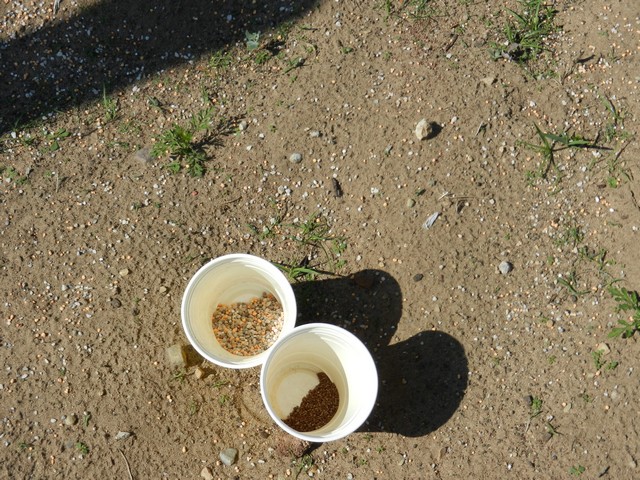
Work the fertilizer into the soil by using a good cultivating tool such as the one below. Just work it in there one way or another. Later on, when side dressing plants that are established and fruiting, just sprinkle it on the soil 1 foot away from the stem and out to the drip line (where the outer leaves end.) Gently work it into the top layers of the soil with a fork or similar, so not to disturb the roots. Then apply water, or wait for rain, which will carry the nutrients down to the roots.
NOTE: Always be careful not to let granular fertilizers come into direct contact with any parts of the plant (leaves, roots etc.), since they can burn the plant.
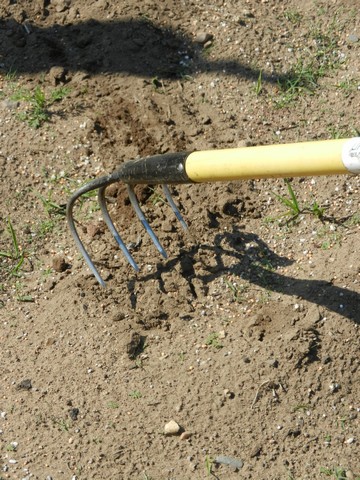
Transplanting tomato plants to the outdoors
To further prepare for planting, your plants might need some pruning. A general rule when planting tomato plants is to plant them deep into the ground, and there’s an important reason why: Have you noticed the little hairs, or white fuzz along the main stem? These little hairs will grow into roots when covered by dirt, and allow for a good, strong root system to support the plant. Isn’t that amazing!? And when planting deep, lower branches that would end up buried will need to be removed.
There are some different opinions on how deep to plant; some say to plant as much as 2/3 of the stem, allowing only the top 1/3 to remain above ground. Others say to only plant a few inches deep. Personally I normally bury up to 2/3 of the stem and the plants grow very well and often very tall. Although with determinate plants such as Roma, I don’t plant quite as deep because they don’t necessarily grow as tall and sometimes it seems I’ve cut off too many branches.
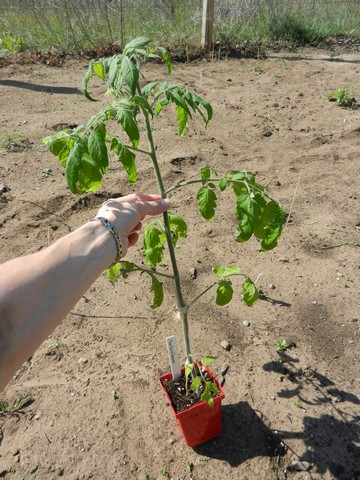
At this stage I can still typically get away with snipping them off using only my finger nails.
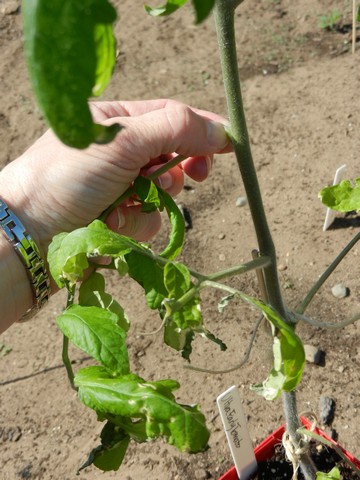
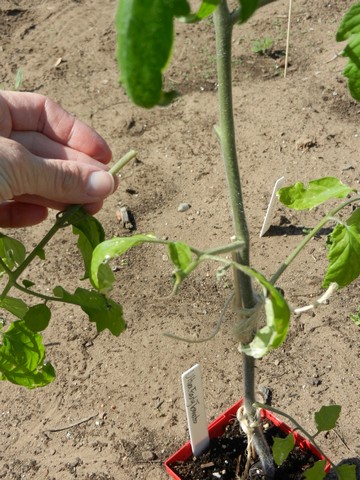
The plant is looking pretty bare right now, but once planted, it will quickly take off and grow large.
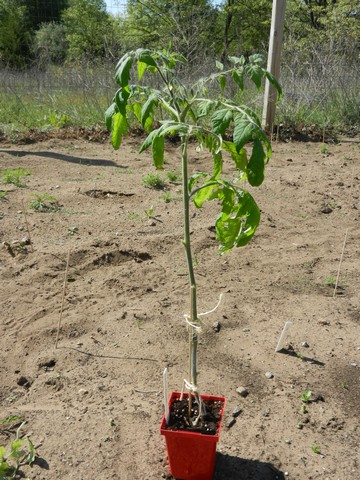
Normally I dig the hole straight down and plant them “standing up”. One year I decided to try what I have seen some gardeners recommend, which is to dig a trench and plant the plants more or less sideways, so that the stem is still buried but the root ball gets to be placed higher up toward the surface where the soil stays nice and warm. Well, after trying it, I don’t think it made much of a difference, it just made it more cumbersome to get the top of the plant off the ground and stay upright since the stem was buried sideways. So I’ve gone back to planting straight down.
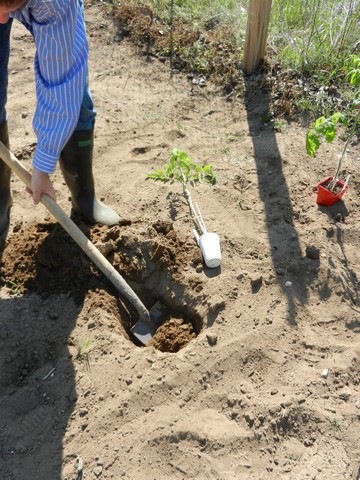
Remove pots and don’t forget to remove the strings from past stakings! The stem will grow thick and sturdy after a while, and a forgotten string can cause considerable damage and strangle the plant.
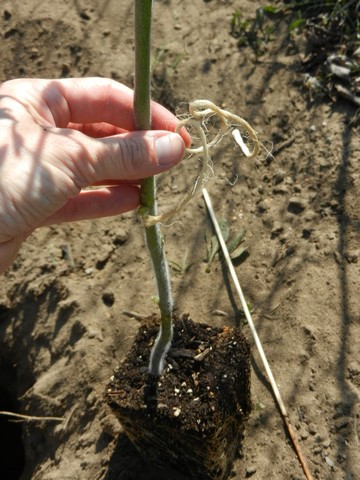
If the roots are growing in circles inside the pot, loosen them, or even cut through some of them to encourage outward growth instead of continuing in a circle. Then into the hole it goes.
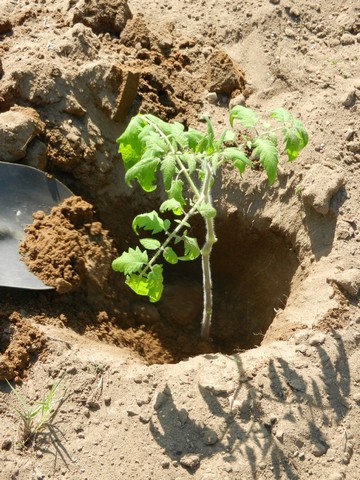
One in, another one waiting. Just don’t forget to water them shortly after planting!! You can even water into the hole when halfway filled, then again when finished planting.

Spacing of the plants depends on the tomato variety, as well as how much room you have in your garden. It’s a good idea to first figure out whether your plants are determinate or indeterminate. Determinate plants will stay more compact and smaller, perfect for containers, while indeterminate plants (such as cherry tomatoes) will continue to grow the entire season. They just never stop! I’ve had plants grow to 7-8 feet tall and so wide that the rows were completely grown over. My father-in-law had one tomato plant grow way up into a nearby tree! Indeterminate plants usually do best with at least 3 feet between plants and 3-6 feet between rows so you can get around them to care for the plants or pick tomatoes. If space is limited, you can try to place them closer together, but more room makes things easier for you and allows for more nutrition, water, and air circulation.
Staking and Pruning
Once they’re in ground, I like to put tomato cages around my plants for support. I reuse them year after year. Add them early on as it can be much trickier later when the plants are big and the branches stick out everywhere. Check the plants almost daily for a period of time so that you can train branches to grow through the cage instead of on the outside. Later in the season, when the plants grow tall and heavy, sturdier staking may be needed. For my in-ground plants I usually end up using snow stakes and 8 foot poles to try to contain my plants, using string to tie up branches and keep them under control. Potted plants are easier to control as they won’t grow as large, but they don’t produce as much fruit, either.
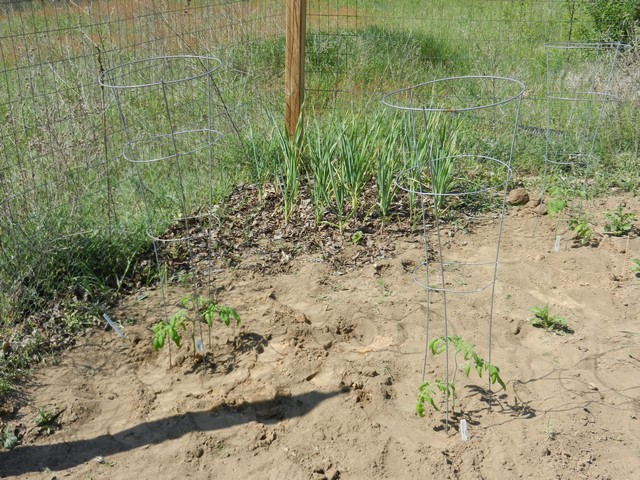
To prune or not to prune, that really is a big question. Again, there is various and conflicting information on pruning practices, but it seems like most gardeners agree that determinate plants should pretty much be left alone (other than possibly removing suckers and bottom branches that are too close to the ground), while indeterminate plants seem to benefit from a certain amount of pruning. I’ve been reading that determinate plants do not need pruning as they stay compact and produce all of their tomatoes at once. Removing branches from these plants often results in a smaller yield. Indeterminate plants, however, will produce larger fruit if pruned, in addition to giving better air flow to prevent bugs and diseases.
For pruning indeterminate plants as they grow larger, this is what I do: I snip off lower branches that are close to the ground, as soil can otherwise splatter up on the leaves and spread disease such as early blight. In addition, I remove suckers.
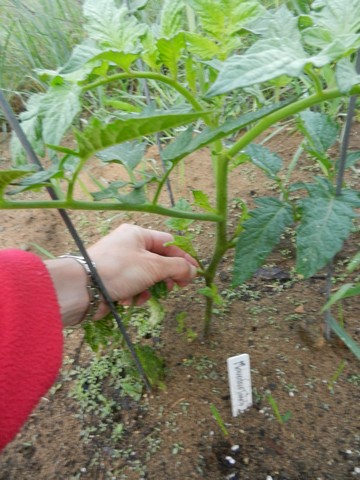
Suckers are the little leaves that grow out in the V between the main stem and true branches. I remove all suckers located below the first set of blooms.

Mulching is helpful as a soil splatter protection, weed control, and also helps keep moisture more even, which will greatly benefit your tomatoes. Mulching options include grass clippings, bark, peat moss, straw, shredded newspapers, and leaves. Black plastic is another alternative.
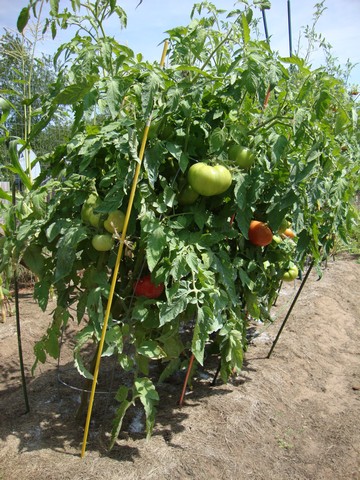
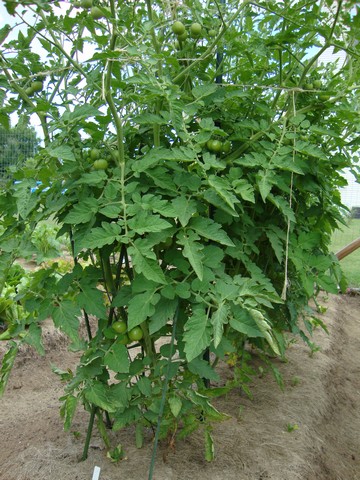
Watering
Tomato plants do need a lot of water, daily if the weather is hot, but not in large quantities at a time. It is important to water evenly; if moisture fluctuates a lot, you can end up with various problems such as cracked tomatoes or blossom end rot. That doesn’t mean they can never ever go dry, but the more evenly the better. I especially try to avoid periods of drought followed by heavy watering. If I notice that my plants are excessively dry, I try to water just a little bit, then wait a while before adding more. I want to encourage them to absorb the water slowly to prevent cracking . I will include more information on how to prevent cracking or blossom end rot in my next post, part 3 of Growing Tomatoes.
Fruiting
It is always fun to see the first blooms! Tomatoes are on their way!!
If the plant seems too young or spindly to be able to support tomatoes, it likely is, so snip the flowers off until the plant has had a chance to grow stronger. Also snip them off if the weather is extreme, causing the plants distress. Removal of flowers will ensure more energy to the plant itself. In addition, you may want to remove blooms 4 weeks before expected frost in your area, to encourage the plant to focus its energy on ripening existing fruit. Once frost hits, your plant is a goner unless you cover it up during frost. I never do; I’m about done at that point, ready for a break.
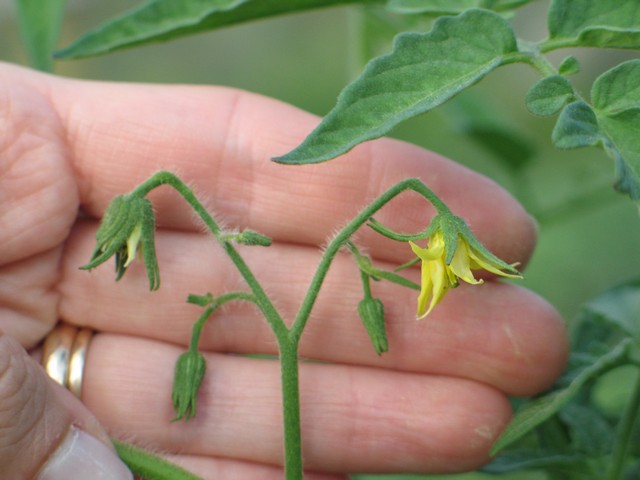
After each yellow little flower is done blooming, it will wither, and in the center there will be a tiny beginning of a tomato.
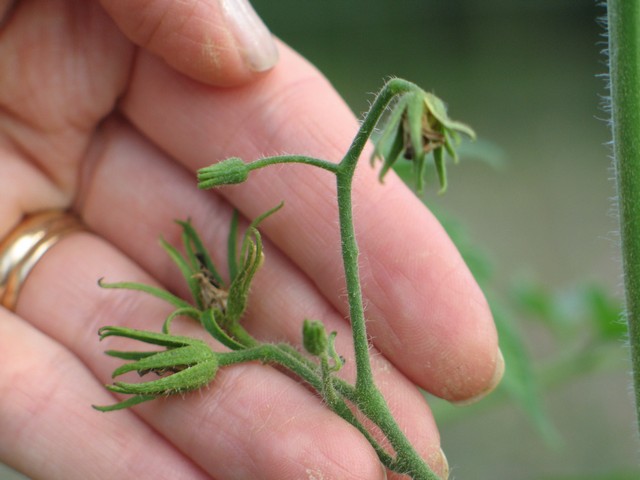
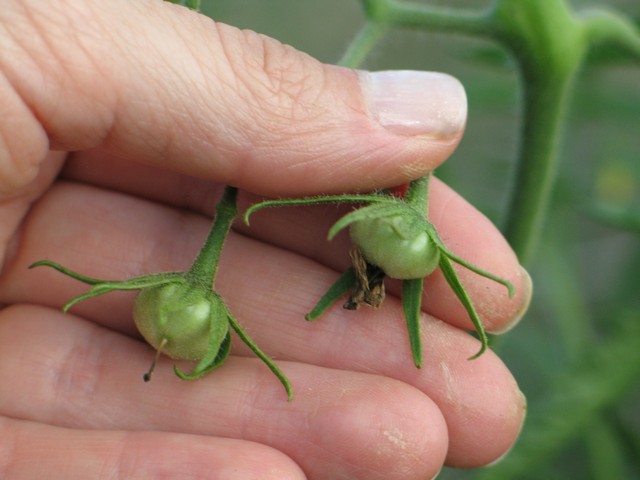

They will keep on growing until they reach the correct size for that plant, whether that’s small as a grape or large as a softball. This one is an heirloom tomato.
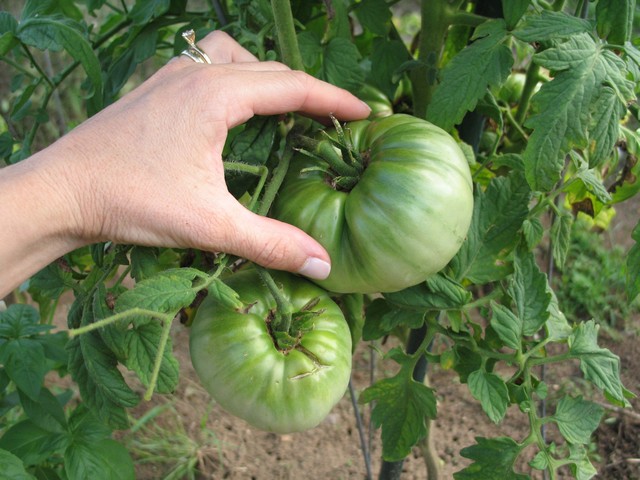
Here are some cherry tomatoes growing:
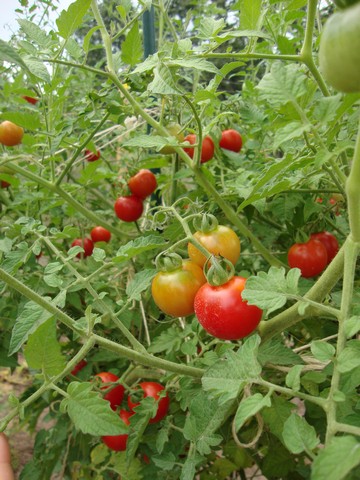
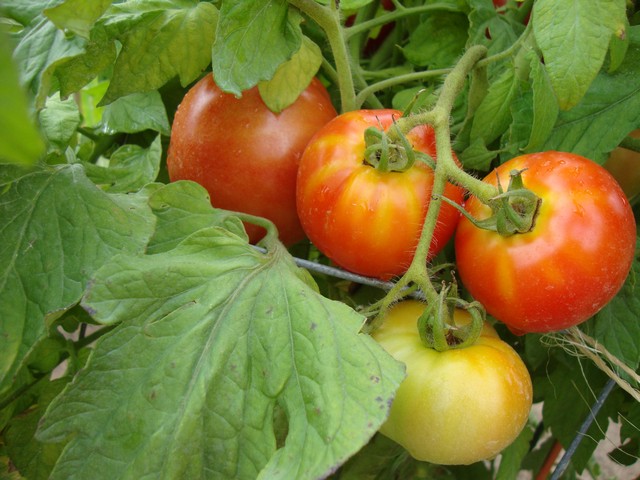
Growing tomatoes is fun and very rewarding. I especially love starting them from seed before taking them through the whole process until harvest. Caring for them until they are ready to be transplanted outdoors is a fairly simple deal once you understand the needs of these plants, and watching them grow large and with ripening fruit is an amazing process! That such a tiny seed can become such an enormous plant! Biting into that first tomato of the season, after having watched and waited patiently (or not so patiently!) makes the work and the wait so worth it, and I just know I will want to do it all again the following season. There really is nothing like a garden tomato that was allowed to ripen on the plant, receiving warmth, sunshine, and a healthy dose of TLC. Though flavor depends on the variety, there is no comparison to supermarket tomatoes. Garden tomatoes are rich and red throughout, and very flavorful.
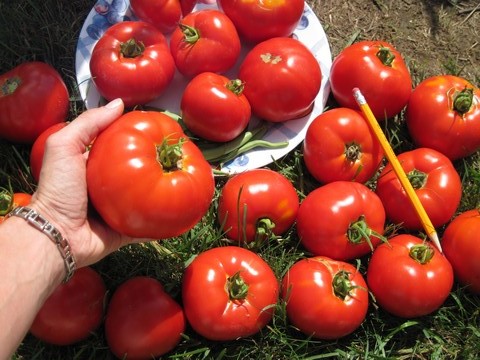

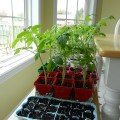

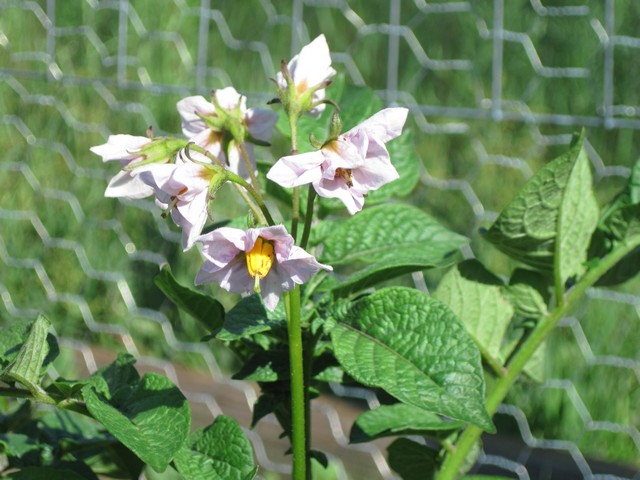
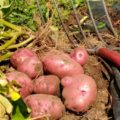

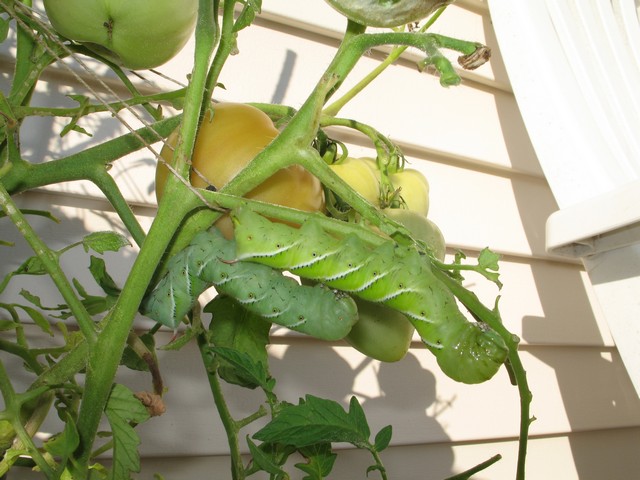
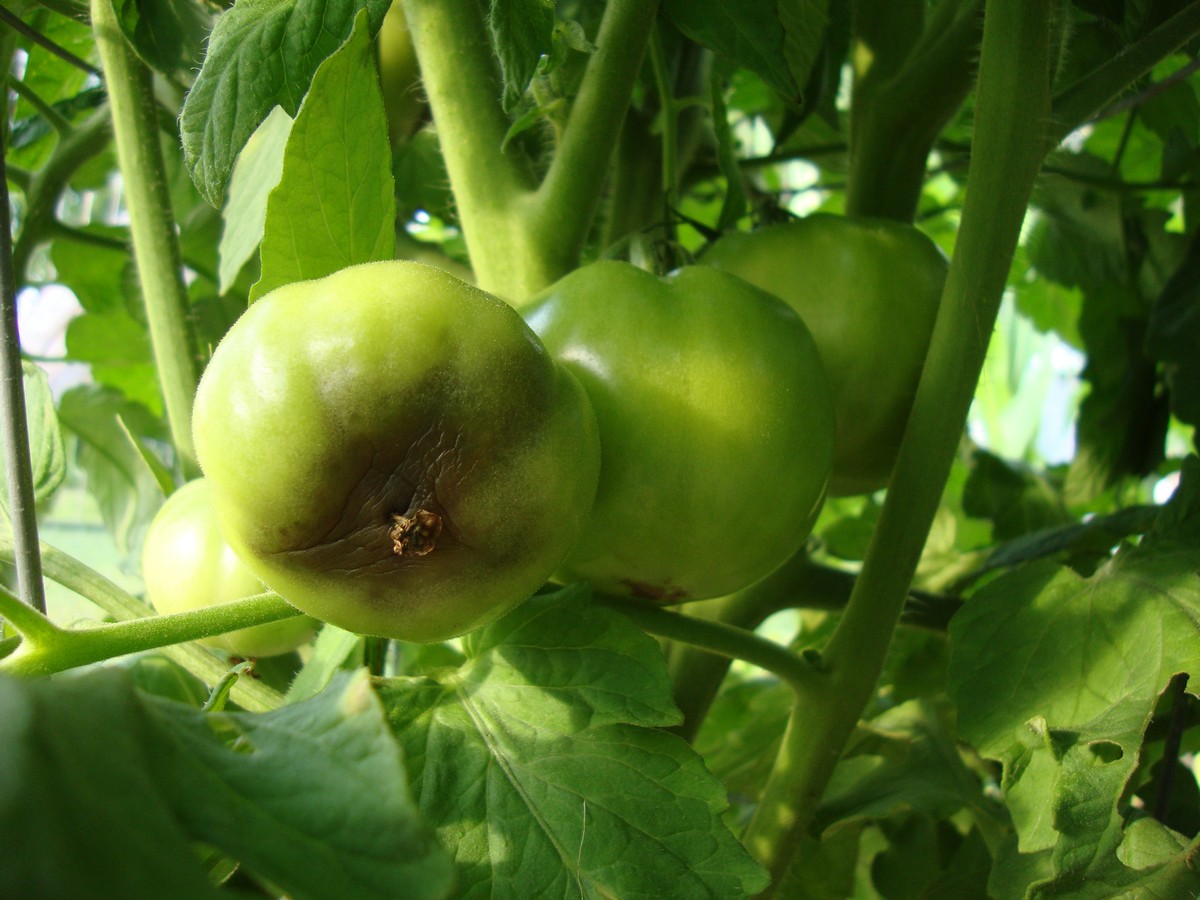
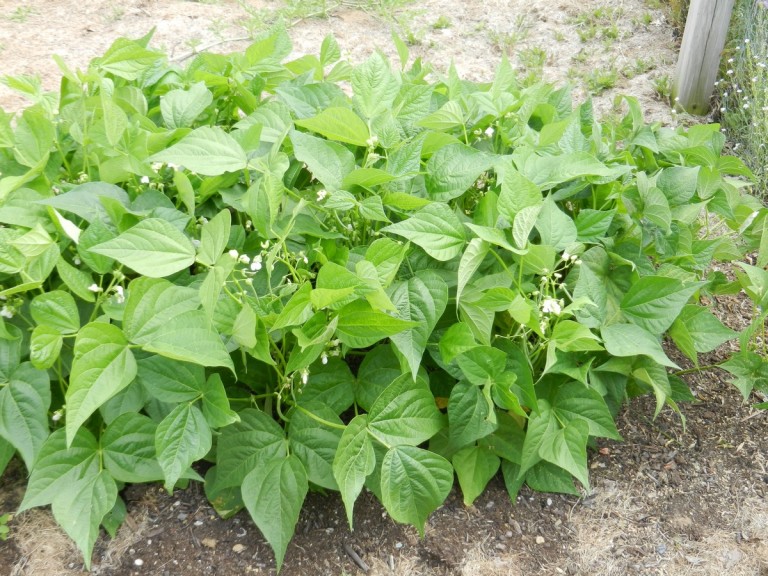
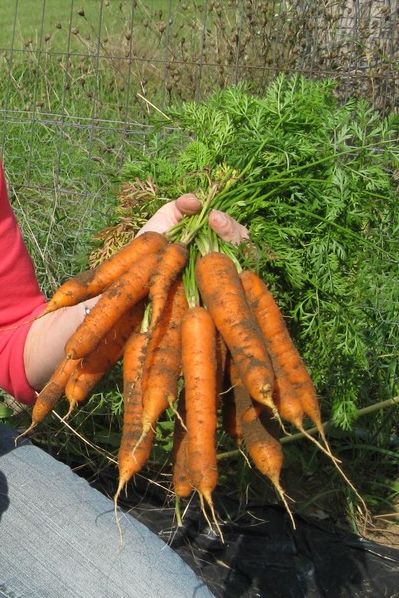
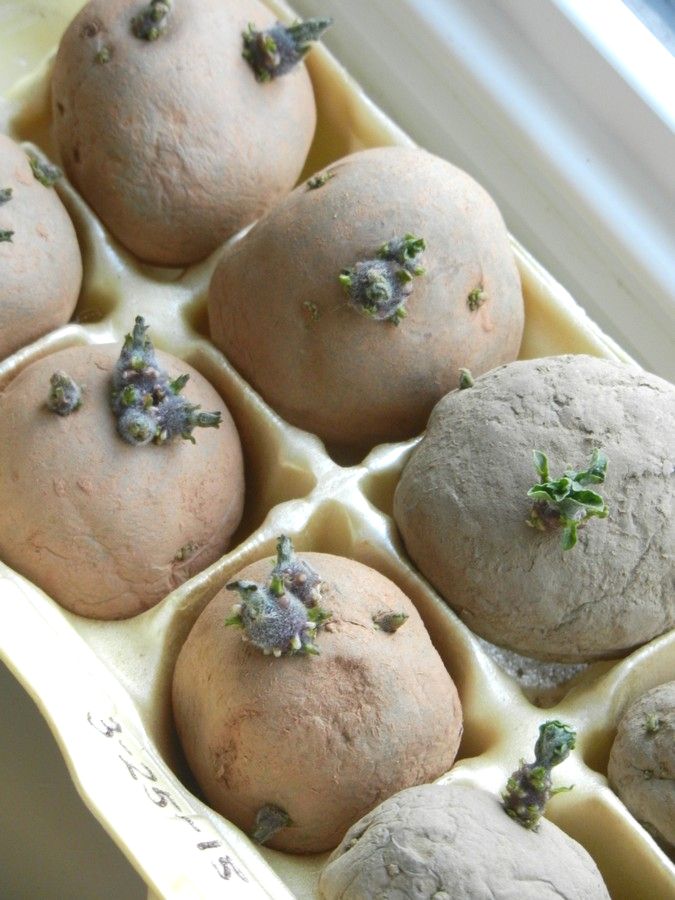

very educational
This was really helpful. Thank you for collecting the information and presenting it in such a readable format. It’s appreciated. I hope you are having a great week. Blessings…Mary
You’re welcome, I’m glad to hear it was helpful! I hope you’ll have a wonderful weekend as well!
By far the most insightful, precise, informative and educative write up on tomato production I have read
Wow, thank you very much! What a great compliment to receive, I really appreciate it!
I am growing about 10 varieties right now. 2nd year growing and I didn’t know what I was doing last year. But this year, 2014, with the great information (Greatly Appreciated !!) I will be extremely happy with my plants (about 20). BTW, I love Cherokee or similar heirloom tomatoes. So flavorful. I used to buy them at Farmer’s market in Los Angels areas, but I will pick my own this year.
Thanks again,
Joe
Thanks for the comment Joe! I hope your plants will do very well for you this year, and that you’ll enjoy the process. Wow, 20 plants should yield a lot of tomatoes, enough to make all kinds of wonderful sauces and salsa to last you all winter!
I have a bunch of plants that I don’t necessarily want to place in the ground outside of my house. I was wondering if you have any idea or thoughts about other planting ideas.
Well, I’ve always done pots or in-ground; pots worked well, but in-ground is better. Otherwise I give away extra plants to friends and family every year, which is very gratifying.
i always wondered what all the fussing was about, and how gardening took time and care. now i know. thanks to you passing on your knowledge, another garden will be better cared for.
The best step by step from seed to table I have encountered!
Wonderful! Thank you!!
This is the best information on growing tomatoes! Thank you so very much!
You’re very welcome, and thank you so much for leaving a comment!
This is definitely the best site in terms of information on how to grow tomatoes step by step. Thank you so much for that!
I am a newbee in tomato planting, and just started my first tomatoes ever from seeds. I am also a stay-at-home mom with two toddlers and a baby, and the first batch of my seedlings had to survive through some major accidents: toddler touching, pinching, ball throwing and eventually falling onto them…
Therefore, since my poor seedlings really did not have a chance to thrive, I just bought a tomato plant in Home Depot. My question is: it was sold outside, and they suggested to keep it outside unless some random frost occurs. However, I am extremely afraid to do so and took it in for the first night. Do you think I should go ahead and just leave it outside tomorrow? The temperatures are ranging between 9-16 Celsius right now.
Thank you again,
Ala
Thank you very much! And wow, I think it’s great that you’re even trying, being busy with such little ones! Good for you! And how wonderful for your kids to have their mommy at home with them! The day will come when you can grow tiny seedlings without a worry.
For your plant from Home Depot, personally I would take it in at night. That way you don’t have to be so diligent about checking for frost warnings, or risking a random frost that was not expected. In addition, tomato plants love warmth, so it seems to me it would thrive better inside at night. They also love the sun though, so if it’s warm and sunny during the day, it would be wise to bring it outside. When it really gets close to planting out, it also is good to keep it outside overnight for several nights to get it fully weathered and prepared. Provided there is no frost, obviously. Enjoy the process! I hope your toddlers will have fun helping you water and pick tomatoes when that time comes. 🙂
I truly enjoyed this article, very helpful to me. I am going on my 5th year of vegetable gardening. I love growing by seed, I think this year will be much better. Thanks to you and all the other experienced gardeners. I will have to say, your article has been the most informative by far.
How nice to hear!! Thank you very much!
Thank you, Terese. Your info for seed starting to planting the tomato plants is A+. I live 30 miles south of Chicago. My husband bought a 5ft. X 8ft. greenhouse a 4 years ago for my June birthday. It’s something I’ve wanted for a long time. It’s my peaceful space . . . I love it! Last year I was finally able to start tomato, bell pepper and flower plants from seed to planting them now in a 4 ft. x 20 ft. raised veggie bed our son and grandsons helped build 2 years ago. Your info has given me a few pointers that will make my plant starting more successful. Thank you! Thank you! 🙂
That’s great to hear, thank you for the compliments! I’m so happy for you that you finally have such a nice area for planting and enjoying! I hope you’ll have a wonderful experience with it!